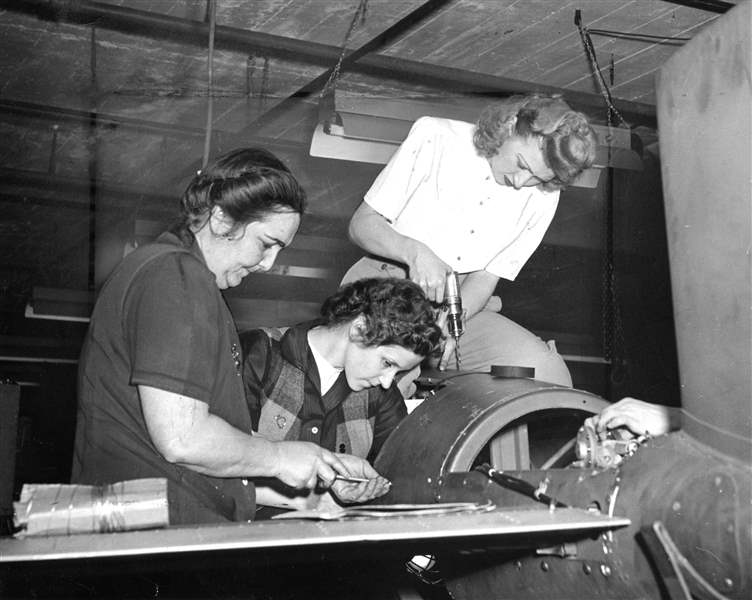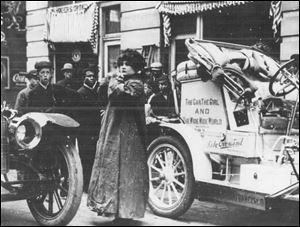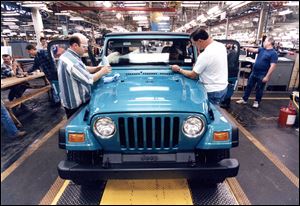
Timeline: Overland, Willys, Dodge, Jeep
8/11/2011
1945: Angela Durieux, Rossford, sits astride one of the robombs produced at the Willys-Overland Motors Inc. plant in Toledo, while Viva Hatt, Lottie Myskinski, and Agnes Mack (hands at right) of Toledo, work on assembling this war weapon.
THE BLADE
Buy This Image

1910: Blanche Scott, known as ‘Lady Overland,’ was hired by Willys-Overland to drive a car all around the country.
1910: John North Willys starts constructing what will become the Jeep Parkway plant in Toledo.
1912: Willys-Overland Motor Co. ranks as the second-largest automaker behind Ford Motor Co. and has 15,000 employees by 1915, making it Toledo’s largest employer.
1928: Jeep Parkway plant reaches an employment peak of 23,000 people, who work in a 7-million-square-foot facility that includes more than 90 buildings and covers 119 acres.
1941: Production of military Jeeps begins, and about 363,000 are assembled at Jeep Parkway during World War II. Trailers, 155mm shells, aircraft parts, rockets, and other military equipment also are made at the factory during
the war.
1945: First civilian Jeep, the CJ-2A and a predecessor of the Jeep Wrangler, is produced at the Jeep Parkway plant. Station wagons, pickups, the sporty Jeepster car, and sport utility vehicles eventually follow.
1953: A Kaiser-Frazer Corp. subsidiary buys Willys-Overland Motors Inc. and changes its name to Willys Motors Inc.
1954: Jeep Parkway plant builds its 5 millionth vehicle.
1964: The Stickney Avenue factory, which would later become part of today’s Chrysler Toledo Assembly complex where Wranglers are made, is purchased from The Electric Auto-Lite Co.
1969: Kaiser Jeep is sold to American Motors Corp. for $70 million. The plant is renamed Jeep Corp.
1983: Production of the Jeep Cherokee and its twin, Wagoneer, begins.
1985: The CJ-7 is moved to Brampton, Ont., and is redesigned as the Wrangler the next year, marking the first time none of a Jeep model’s production comes from the Jeep Parkway plant.
1987: Chrysler Corp. acquires AMC, including Jeep, for $1.5 billion.

1945: Angela Durieux, Rossford, sits astride one of the robombs produced at the Willys-Overland Motors Inc. plant in Toledo, while Viva Hatt, Lottie Myskinski, and Agnes Mack (hands at right) of Toledo, work on assembling this war weapon.
1991: Chrysler announces it will discontinue production of the Grand Wagoneer and close the Stickney Avenue plant, laying off nearly 1,000 workers. Later, reports say Chrysler will reopen the plant to build Wranglers when the vehicle resumes production in Toledo the next year.
1992: The first Wrangler is made at the Stickney Avenue plant.
1993-95: Chrysler Toledo Jeep plant made Dodge Dakota pickup trucks.
1997: Chrysler announces plans to invest $1.2 billion in Toledo to build a new Jeep factory, making a replacement for the Cherokee.
1998: Chrysler Corp. merges with Daimler-Benz to form DaimlerChrysler AG.
2001: Production of the Jeep Cherokee ends at the Jeep Parkway plant, and begins with the replacement Jeep Liberty at the new Toledo Assembly plant a few miles away on Chrysler Drive. Wrangler production continues at Jeep Parkway and Stickney Avenue.
2002: Demolition begins on parts of the former Jeep Parkway plant.
2003: DaimlerChrysler AG and United Auto Workers Local 12 negotiate an agreement unique to North America, under which, as part of a $2.1 billion expansion in Toledo next to the Liberty plant, suppliers would own and operate some factories used to make the Wrangler and another vehicle off its platform.
2004: Construction begins on the $900 million multifactory plant between Stickney Avenue and Chrysler Drive that will build two and four-door versions of the redesigned Wrangler.
2005: Chrysler and UAW offi cials announce the Toledo Assembly complex factory where the Liberty is made also will make the Dodge Nitro SUV in 2006.
2006: Production ends at Jeep Parkway, closing the nation’s longest running automotive plant. The plant produced roughly 11 million vehicles, from Overland cars to Jeeps.

1996: Ken Wieland and Dave Pixley put the finishing touches on the first Wrangler TJ to come off the line at the Stickney Avenue Jeep plant.
2007: The four-door Jeep Wrangler debuts and boosts U.S. Wrangler sales in its first year by nearly 50 percent.
2007: Chrysler Group is sold to private-equity fi rm Cerberus Capital Management for $7.4 billion.
2009: Automotive sales in the United States fall to their lowest level in decades. With no hope of receiving private financing, Chrysler LLC enters Chapter 11 bankruptcy protection, with the U.S., Canadian, and Ontario governments providing debtor-in-possession fi nancing to allow the automaker to undergo an expedited bankruptcy process. Vehicle production is halted and tens of thousands of employees laid off, but most are brought back once the company emerges from bankruptcy as Chrysler Group LLC. The automaker is under the management of Italian automaker Fiat SpA and its chief executive, Sergio Marchionne.
November, 2009: Chrysler Group unveils a five-year business plan that calls, in part, for a massive product intervention and a new emphasis on leveraging Fiat’s worldwide dealer network to export vehicles, especially the Jeep brand, into world markets where it hadn’t been a player before.
January, 2011: Executives unveil the last of 16 different new or refreshed Chrysler, Dodge, Jeep, and Ram vehicles to be launched over a hectic 18-month product onslaught. Speaking to The Blade during the North American International Auto Show in Detroit, Mr. Marchionne says he expects an announcement about production in Toledo “within six months.”
June, 2011: In an air quality permit application filed with the Ohio Environmental Protection Agency, Chrysler reveals it plans to expand production of its Toledo Assembly complex where Liberty and Nitro vehicles are made by up to 327,000 vehicles annually. The next month, the permit is approved.
August, 2011: Chrysler seeks tax breaks from the city, and reveals that it will invest $365 million over 16 months at its Toledo Assembly complex, adding over 1,100 new jobs, allotting $8 million for body shop expansion, and spending $357 million for tooling and equipment. The company says the project will be finished by 2013 and add $36 million to Jeep’s payroll.